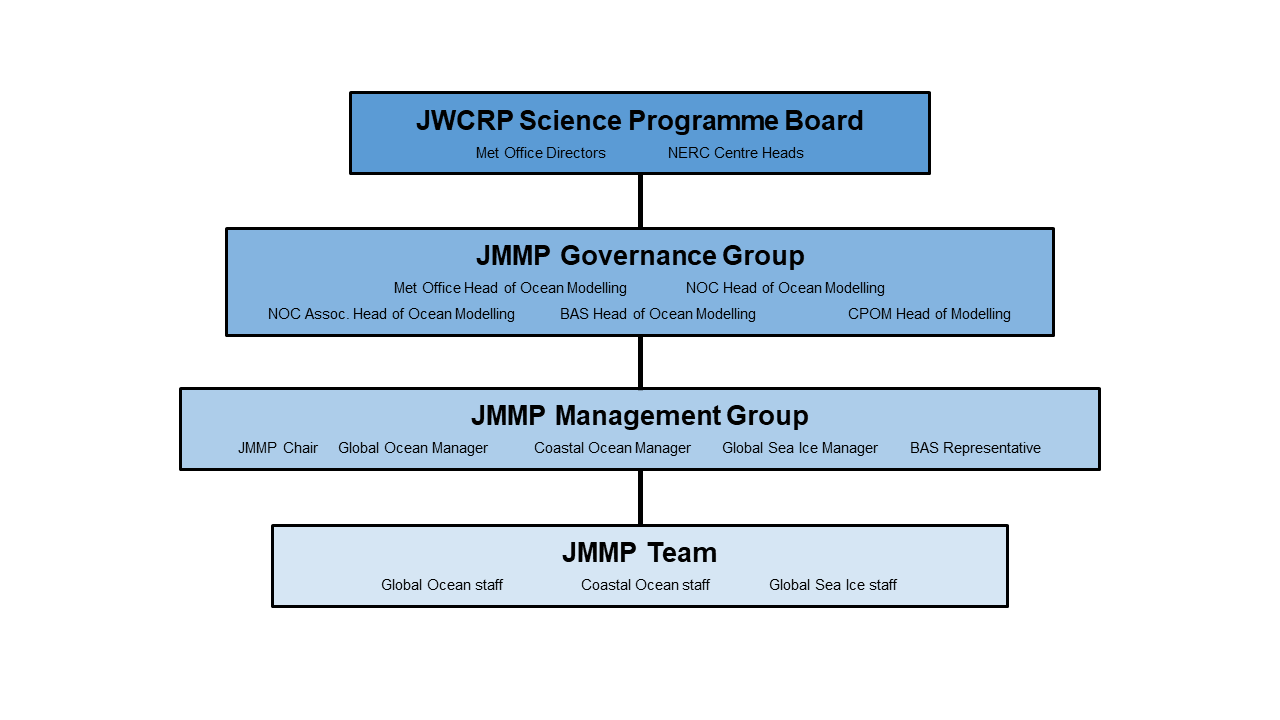Joint Marine Modelling Programme (JMMP)
A partnership between the Met Office and British Antarctic Survey, National Oceanography Centre and Centre for Polar Observation and Modelling.
The Joint Marine Modelling Programme (JMMP) provides world-class and easily accessible national capability, ocean modelling infrastructure and configurations to support the UK’s scientific research and operational prediction systems for ocean, weather and climate.
Model configurations are underpinned by the Nucleus for European Modelling of the Ocean (NEMO) framework. JMMP works closely with the NEMO consortium to develop the underpinning model capability.
The work of JMMP is planned to specifically address user needs. The JMMP team works across the four institutes.
Contents
Partnership Aims
- Act as a central hub for global and shelf marine modelling in the UK with data and model configurations easily accessible.
- Develop world-leading configurations of the global ocean and the North West shelf region.
- Develop configurations at a range of resolutions for different applications.
- Develop configurations of the global ocean that adequately represent shelf areas.
- Attract pull-through to the JMMP configurations from UK research and use model output for leading science.
Governance
The governance structure for JMMP is shown in Figure 1 and comprises of the Joint Weather and Climate Research Programme (JWCRP) delegating overall governance of JMMP to the JMMP governance group. The JMMP chair has executive responsibility for management of the programme.

Figure 1: Schematic of JMMP organisation
JMMP Model Configurations
We deliver configurations of global ocean and sea ice (GOSI), and the North West shelf region (Coastal Ocean: CO) based on NEMO to operational and academic users.
Global Ocean & Sea Ice
JMMP global configurations are used as part of the Met Office Climate and Earth System, seasonal prediction and weather forecast models.
JMMP maintains a traceable hierarchy of three resolutions of the combined global ocean and sea ice configurations. These resolutions are nominally 1 degree, 1/4 degree and 1/12 degree. "Traceable" means that the only numerical differences between the configurations are those that can be justified as being required by the change in resolution.
Current areas of development include:
- Work on the near-surface mixing scheme based on the OSMOSIS project.
- Focus on improving the Southern Ocean circulation at 1/4 degree.
- Testing options for reducing spurious numerical diapycnal mixing.
- Changing the sea ice model component from using CICE to using NEMO’s new native sea ice model SI3.
There are two new Process Evaluation Groups associated with the Global Ocean and Sea Ice development focussed on the North Atlantic and Southern Ocean. These groups take a broad assessment of the performance of the models in the area of interest and use identified deficiencies in the model to stimulate model development activity.
Coastal Ocean
We maintain two resolutions of North West European Shelf configurations at 7km and 1.5km resolution.
The 1.5km resolution configuration is eddy-resolving and has been implemented operationally (CO8_AMM15). This replaced the 7km resolution configuration for forecast products but remains the principal configuration for long reanalysis and couple biogeochemistry work.
Current development activities include:
-
Improved representation of vertical structure across the domain, from coast to ocean, using multi-envelope techniques for the vertical levels.
-
Updated bathymetry
-
Wetting and drying capability at the tidal interface with the coastline
A new Shelf Enabled Global configuration is being developed to draw together expertise from across the Coastal Ocean and Global Themes and deliver a global model capable of representing shelf edge processes. Target applications include:
A. Global ecosystem and biogeochemical assessment and impact
B. Global sea level impacts at regional scale
C. Global impacts on shelf sea processes
Reference list
Global Ocean and Sea Ice
Storkey, D., Blaker, A. T., Mathiot, P., Megann, A., Aksenov, Y., Blockley, E. W., Calvert, D., Graham, T., Hewitt, H. T., Hyder, P., Kuhlbrodt, T., Rae, J. G. L., and Sinha, B.: “UK Global Ocean GO6 and GO7: a traceable hierarchy of model resolutions”, Geoscientific Model Development, 11, 3187-3213, https://doi.org/10.5194/gmd-11-3187-2018, 2018.
https://www.bodc.ac.uk/projects/data_management/uk/osmosis/
Ridley, J. K., Blockley, E. W., Keen, A. B., Rae, J. G. L., West, A. E., and Schroeder, D.: The sea ice model component of HadGEM3-GC3.1, Geosci. Model Dev., 11, 713–723, https://doi.org/10.5194/gmd-11-713-2018, 2018.
Coastal Ocean
Tonani, Sykes, King, McConnell, Pequignet, O’Dea, Graham, Polton, Siddorn (2019), The impact of a new high-resolution ocean model on the Met Office North-West European Shelf forecasting system. Ocean Sci.,15(4), https://doi.org/10.5194/os-15-1133-2019.
Graham, J. A., E. O’Dea, J. Holt, J. Polton, H.T. Hewitt, R. Furner, K. Guihou, A. Brereton, A. Arnold, S. Wakelin, J.M. Castillo Sanchez, C.G. Mayorga Adame (2018) AMM15: A new high resolution NEMO configuration for operational simulation of the European north-west shelf, Geosci. Model Dev., 11(2), 681-696, https://doi:10.5194/gmd-11-681-2018 .
Guihou K., J.A. Polton, J. Harle, S. Wakelin, E. O’Dea, J. Holt (2018) Kilometric scale modeling of the North West European Shelf Seas: Exploring the spatial and temporal variability of internal tides. J. Geophys. Research: Oceans, 123:688-707, doi:10.1002/2017JC012960.
Recent Science References
Inall, Toberman, Polton, Palmer, Green, Rippeth (2021). Shelf seas baroclinic energy loss: pycnocline mixing and bottom boundary layer dissipation, Journal of Geophysical Research - Oceans, 126(8). http://dx.doi.org/10.1029/2020JC016528
Luneva M.V., S. Wakelin, J. Holt, M.E. Inall, I.E. Kozlov, M.R. Palmer, M. Toberman, E.V. Zubkova, J.A. Polton (2019), Challenging vertical turbulence mixing schemes in a tidally ener- getic environment: Part I. 3D shelf-sea model assessment, J. Geophys. Res., 124, 6360 - 6387,https://doi.org/10.1029/2018JC014307.
Holt, J., J. Polton, J. Huthnance, S. Wakelin, E. O’Dea, J. Harle, A. Yool, Y. Artoli, J. Blackford, J. Siddorn, M. Inall (2018) Climate-driven change in the North Atlantic and Arctic Ocean can greatly reduce the circulation of the North Sea, GRL, https://doi.org/10.1029/2018GL078878.


